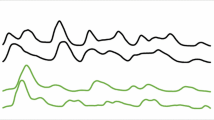Abstract
In this paper, a novel method (Hybrid–ELM–PLSR) is proposed based on hybrid variable selection algorithm and improved extreme learning machine (ELM) for multivariate chaotic time series prediction. The hybrid variable selection algorithm combines the advantages of filter and wrapper, effectively balancing the calculation speed and prediction accuracy. Moreover, for ELM, multicollinearity, which can result in ill-condition, is always existent among the hidden layer output matrix. And the optimal number of hidden nodes is also difficult to be determined. Therefore,in order to overcome these problems, an improved ELM (ELM–PLSR) is proposed based on partial least square regression (PLSR). It can effectively enhance the stability performance and prediction performance of ELM. Hybrid–ELM–PLSR can be divided into three stages. At first, filter is used to rearrange the input variables through the correlations with desired variables. Then wrapper is used to select the optimal variable subset through evaluating the prediction performance of different subsets. Finally, ELM–PLSR is used to build the prediction model. The simulation experiment results based on San Francisco river runoff dataset demonstrate that the proposed method is effective for multivariate chaotic time series. And the prediction accuracy and reliability are higher than other methods.





Similar content being viewed by others
References
Araújo RA (2013) Evolutionary learning processes to design the dilation-erosion perceptron for weather forecasting. Neural Process Lett 37(3):303–333
Han M, Xu M (2015) Predicting multivariate time series using subspace echo state network. Neural Process Lett 41(2):201–209
Gao ZK, Yang Y, Zhai L et al (2016) A four-sector conductance method for measuring and characterizing low-velocity oil-water two-phase flows. IEEE Trans Instrum Meas 65(7):1690–1697
Gao ZK, Fang PC, Ding MS et al (2015) Multivariate weighted complex network analysis for characterizing nonlinear dynamic behavior in two-phase flow. Exp Therm Fluid Sci 60:157–164
Ertaç M, Firuzan E, Solum Ş (2015) Forecasting Istanbul monthly temperature by multivariate partial least square. Theor Appl Climatol 121(1–2):253–265
Runge J, Heitzig J, Petoukhov V et al (2012) Escaping the curse of dimensionality in estimating multivariate transfer entropy. Phys Rev Lett 108(25):258701
Chandrashekar G, Sahin F (2014) A survey on feature selection methods. Comput Electr Eng 40(1):16–28
Jaeger H (2001) The echo state approach to analysing and training recurrent neural networks-with an erratum note. Bonn Ger Ger Natl Res Cent Inf Technol GMD Tech Rep 148:34
Termenon M, Graña M, Barrós-Loscertales A et al (2013) Extreme learning machines for feature selection and classification of cocaine dependent patients on structural MRI data. Neural Process Lett 38(3):375–387
Boulet JC, Bertrand D, Mazerolles G et al (2013) A family of regression methods derived from standard PLSR. Chemometr Intell Lab Syst 120:116–125
Tang J, Wang D, Chai T (2012) Predicting mill load using partial least squares and extreme learning machines. Soft Comput 16(9):1585–1594
Li S, Li L, Milliken R et al (2012) Hybridization of partial least squares and neural network models for quantifying lunar surface minerals. Icarus 221(1):208–225
Castaño A, Fernández-Navarro F, Hervás-Martínez C (2013) PCA-ELM: a robust and pruned extreme learning machine approach based on principal component analysis. Neural Process Lett 37(3):1–16
Wong SY, Yap KS, Yap HJ et al (2015) A truly online learning algorithm using hybrid fuzzy ARTMAP and online extreme learning machine for pattern classification. Neural Process Lett 42(3):585–602
Xin-Ying W, Min H (2015) Multivariate chaotic time series prediction using multiple kernel extreme learning machine. Acta Phys Sin 64(7):070504
Duzan H, Shariff NSBM (2015) Ridge regression for solving the multicollinearity problem: review of methods and models. J Appl Sci 15(3):392
Wold H (1985) Partial least squares. In: Kotz S, Johnson NL (eds) Encyclopedia of statistical sciences, vol 6. Wiley, New York, pp 581–591
Vergara JR, Estévez PA (2014) A review of feature selection methods based on mutual information. Neural Comput Appl 24(1):175–186
Battiti R (1994) Using mutual information for selecting features in supervised neural net learning. IEEE Trans Neural Netw 5(4):537–550
Hipel KW, McLeod AI (1994) Time series modelling of water resources and environmental systems. Elsevier, Amsterdam, p 553
Muñoz-Gutiérrez MA, Reyes-Ruiz M, Pichardo B (2015) Chaotic dynamics of Comet 1P/Halley: Lyapunov exponent and survival time expectancy. Mon Not R Astron Soc 447(4):3775–3784
Gao ZK, Jin ND (2012) A directed weighted complex network for characterizing chaotic dynamics from time series. Nonlinear Anal Real World Appl 13(2):947–952
Shiina T, Nitta N, Ueno EI et al (2002) Real time tissue elasticity imaging using the combined autocorrelation method. J Med Ultrason 29(3):119–128
Cao L (1997) Practical method for determining the minimum embedding dimension of a scalar time series. Phys D 110(1):43–50
Acknowledgements
This research was supported by the project of the National Natural Science Foundation of China (No. 61374154).
Author information
Authors and Affiliations
Corresponding author
Rights and permissions
About this article
Cite this article
Han, M., Zhang, R. & Xu, M. Multivariate Chaotic Time Series Prediction Based on ELM–PLSR and Hybrid Variable Selection Algorithm. Neural Process Lett 46, 705–717 (2017). https://doi.org/10.1007/s11063-017-9616-4
Published:
Issue Date:
DOI: https://doi.org/10.1007/s11063-017-9616-4




